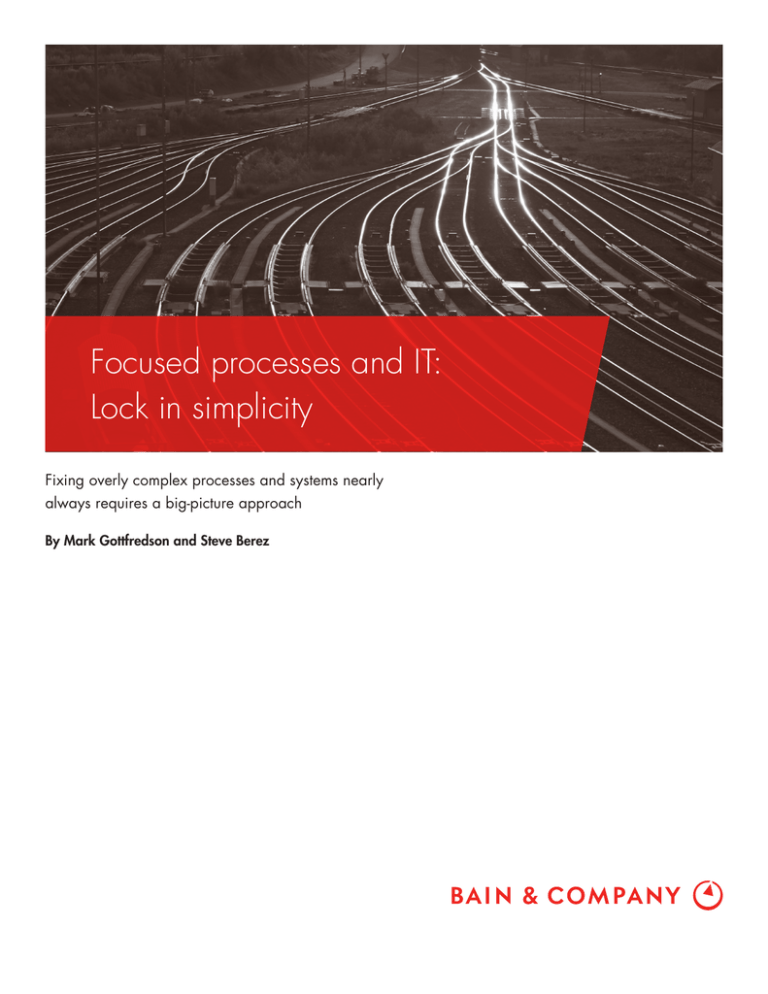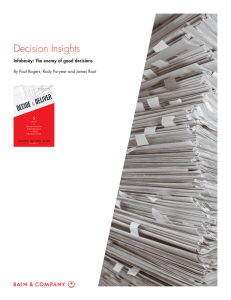
Focused processes and IT:
Lock in simplicity
Fixing overly complex processes and systems nearly
always requires a big-picture approach
By Mark Gottfredson and Steve Berez
Mark Gottfredson is a partner with Bain & Company in Dallas and a senior
member of the Global Performance Improvement practice. Steve Berez is
a Bain partner in Boston and a senior member of the firm’s Information
Technology practice.
Copyright © 2012 Bain & Company, Inc. All rights reserved.
Focused processes and IT: Lock in simplicity
Business processes and IT systems often don’t function
smoothly; costs mount, cycle time increases, computers
freeze up and decisions slow down. To fix such problems,
companies typically rely on process redesign tools, such
as reengineering or Lean Six Sigma. They might revamp
their enterprise resource planning (ERP) systems or
other IT modules.
substantial. Not only do the companies solve their immediate problem—they lock in simplification throughout
the organization. They may begin with processes and
systems, but they wind up with a more focused company.
The best way to understand the approach is to consider
some examples, both in organizational processes and
in IT systems.
Solutions like these are powerful. They can sometimes
streamline processes and systems and unlock value. But
they often fail to deliver the desired benefits, because
complexity just pops up somewhere else. A global energy
company, for example, spent close to $100 million on
seemingly successful reengineering initiatives, yet general
and administrative (G&A) costs continued to climb at a
rate of 15% a year. One frustrated executive told us, “If you
add up all the savings we’re supposed to get from the
reengineering, we should have negative G&A right now.
Instead it keeps on going up.” The same company had
installed a new ERP system in hopes that it would deliver
better value and save money. Yet IT costs were shooting
through the roof.
Focused processes
At the energy company, as at many enterprises, the
finance department spent a large fraction of its time
generating reports. Staff members collected data, analyzed it, prepared the reports and then circulated them
to operating managers. A conventional process-oriented
solution might try to optimize this function. It would
most likely reduce costs by 10% or 15%.
Why do conventional solutions to process and IT issues
regularly come up short? The reason is that processes and
IT are rarely the main problem. Nearly always, process
and IT troubles reflect complexity elsewhere in the
company—in strategy, in business and product portfolios,
and in the organization itself. The complexity may show
up first in process breakdown or system proliferation,
but its root causes often lie elsewhere. That’s why the
benefits of fixing processes or systems alone rarely live
up to expectations. Functional units usually see themselves as service organizations, responsible for supporting
the company’s other functions and operations. They can
streamline themselves, but they rarely question the
demands of their customers.
But this company had already seen too much process
reengineering, so it took the approach we’re describing
in this article. Looking beyond the walls of the finance
department, a team sought out the customers of all the
reports—the operating managers. Team members reviewed every report with these managers, asking how
the report was being used and what would happen if it
was discontinued. “Many meetings were almost comical,”
one participant recalls. “People would say, ‘Would you
describe that report again? I don’t think I’ve ever seen
it.’” The team also examined whether the reports contributed to the company’s current strategy and key metrics.
Many had been developed years earlier and were no
longer relevant to the handful of critical measures the
newly focused company relied on. Thanks to this higherlevel cross-functional review, the company was able to
eliminate a full half of the finance department’s managerial reporting and close to half of its costs.
Some companies have developed a different approach.
Rather than try to fix processes solely through functional
excellence or fix IT solely through systems modernization,
they work the interfaces or nodes where business units
and functions intersect. They address not just the process
or system itself but also the root causes of complexity in
the overall framework (see Figures 1 and 2). The
payoff from this kind of cross-boundary approach is
That’s a relatively simple example, but the approach works
as well with more complex process issues. Consider the
chemical company mentioned in the introductory article
of this series at www.bain.com/FocusedCompany. The
company was suffering from too much downtime, late
deliveries to customers and low overall use of machinery.
Each time it ran a new product through its equipment,
it had to do a complete cleanout. The changeovers were
1
Focused processes and IT: Lock in simplicity
Figure 1: Lean Six Sigma and other tools can optimize processes within a unit or function…
Examples of unit or function optimization
Corporate
Business units
Functions
E.g., Overtime
reduction in
finance
Functions
Functions
Functions
E.g., Machinery
setup and
changeover
improvements
E.g., Plant
cleanliness and
work flow
improvement
Source: Bain & Company
Figure 2: …but there is more value in attacking complexity at the nodes of interaction, addressing root causes
Examples of complexity reduction at nodes of interaction
Corporate
E.g., Corporate strategy assessment:
divestiture of noncore businesses to
simplify cross-business-unit processes
Business units
Functions
Functions
Functions
Functions
E.g., Product portfolio complexity reduction:
simplify processes and systems across the business
unit (R&D, manufacturing, supply chain)
Source: Bain & Company
2
E.g., Incentive
realignment: minimize
complexity upstream
to simplify processes
downstream
Focused processes and IT: Lock in simplicity
time-consuming and expensive, and overall equipment
efficiency was about 33%.
At first, the company tried to improve cycle times through
Lean Six Sigma techniques. It altered the scheduling, for
example, and developed new methods for changeovers.
These measures raised overall efficiency from 33% to about
40%. But then a team began asking the kinds of crossfunctional, outside-the-four-walls-of-the-plant questions
that the energy company had asked. Why is our product
line so complex? Why do we have so many changeovers?
The questions took the team on a voyage of discovery.
Members learned that the marketing and product development functions had created unnecessary and unwanted
product varieties. They learned that engineers were scheduling product runs without consolidating orders and
without considering the trade-off between production efficiency and inventory costs. They discovered that operators
in the plant were overruling the engineers’ schedules
because of machine breakdowns and material delays.
•
At the energy company, as we noted, IT expense
was skyrocketing. The company’s business units
had been requesting all kinds of customized applications, each one adding costs and complexity. Were
all those applications really necessary? When the
company installed its new ERP system, it began
allocating the system’s costs to the business units—
but those allocations weren’t counted in determining
a unit manager’s financial performance. The managers, not surprisingly, regarded IT as essentially
a free resource and didn’t consider cost in their
customization requests.
•
Royal Caribbean, a leading global cruise line, made
several acquisitions, which it maintained as separate
brands. Unfortunately, the brands had three different
shipboard IT systems, adding immeasurably to the
complexity of operating the fleet. Royal could have
saved money and improved its capabilities by consolidating the brands under one system. But where
was the incentive to do so? Brand executives couldn’t
“see” the costs of the individual systems in their
allocations from corporate. They had no reason to
approve the pain and disruption of consolidating
the systems. To fix the problem, Royal had to create
transparent IT costing. It is now rolling out uniform
advanced shipboard systems fleet-wide, with support
from the brands.
•
A few years ago EMC, a leader in data storage, information management and cloud computing, decided
to replace its decade-old financial and manufacturing
system. Originally based on an off-the-shelf package
from Oracle, the system had grown to include 10
million lines of custom code, much of it driven by
complexity in EMC’s business policies. To keep customization below 10% in the new system, EMC
simplified many of those policies. For example, it
eliminated most of the 100-plus special codes related
to crediting revenue from each order.
All these discoveries enabled the company to take a series
of measures aimed at simplifying the entire system, well
beyond the scope of the original issue. Soon the plant
was running at 67% efficiency—an effective doubling
of capacity, with little additional capital investment.
Focused IT systems
IT systems are notorious for their complexity. Often the
reason is simple: As a legacy system ages, intrepid IT
departments create updates, new modules, work-arounds,
software fixes and other sorts of patches. In any given
instance, the cost of a short-term repair or improvement
is far lower than the cost of overhauling the entire system,
so the complexity just gets worse. The only long-term
solution is to redo the whole thing. (Moreover, IT departments can be victims of their own organizational complexity, including a lack of clarity in decision making
and convoluted governance systems. We’ll discuss those
issues in other articles in this series.)
The importance of focused processes and IT
But like business processes, IT systems don’t exist in
isolation, and in many cases the source of complexity
lies outside the walls of the IT department. Consider
these examples:
As you can see from the examples, processes and systems
affect, and are affected by, a company’s strategy, business
units, product portfolio and organizational policies. Thus
3
Focused processes and IT: Lock in simplicity
When you modernize an IT system, you can use that
opportunity to simplify processes and the sources of complexity that affect them. This will lock in simplicity rather
than perpetuating complexity. When new processes are cemented into place through IT systems, the savings persist.
creating focused processes and IT systems is no small
matter. What follows are some lessons companies have
learned as they attack their process and IT issues.
Functional excellence produces some benefits, but most
of the benefits come from solving issues at the nodes.
Typically, no one has been working to optimize the overall
framework, so there are big opportunities for simplification. Look at the difference between the 10% to 15%
savings the energy company might have achieved by
streamlining its finance function and the 50% savings
it attained by working the nodes.
But don’t let the cement dry too soon. Once installed,
processes and IT systems create organizational inertia
and are hard to change. Redesigning a process or replacing a system before simplifying strategies, product
lines and other parts of a company’s operation is exactly backward. It’s like a real estate developer laying
out the electrical grid for a new housing complex before
deciding where the houses will go.
Solving complexity at the nodes means seeing problems
through a general manager’s lens. General managers
have to understand how functions work together to
accomplish the company’s mission. Functional executives
are unlikely to have the necessary perspective. The companies we cited had gone for years without looking at
the big picture. That failure was costing them millions
of dollars.
The right level of complexity is determined by customers.
Companies gain advantage by doing things that competitors can’t do as well. If your customers value complex
combinations of products and services—and if you can
serve these customers profitably—then you will need
some complexity in your processes and IT systems. IKEA’s
processes and systems, for example, require some complexity—how else could the company supply 338 stores
in 40 countries with a constant stream of innovative
products while lowering costs on existing ones? The point
is to eliminate unnecessary complexity, and you will most
often find that customers require much less variety than
you are currently offering. Focusing on true customer
needs will help you find the balance point where what
you offer is exactly what customers value and will pay for.
Clarity around decision rights, authority and accountability
is critical to progress. If people don’t know who is responsible for the key decisions in a process—or, worse, if the
wrong people are responsible—the process won’t work
smoothly. At the chemical company, engineers were
making one set of decisions about scheduling, and plant
operators were overruling those decisions, leading to
scheduling chaos. The process could operate correctly
only when the company identified the individuals with
the best view of scheduling issues and gave them explicit
decision rights.
Many of a company’s most important processes and
systems are those that cross business units and connect
different functions and departments. Unnecessary complexity crops up most often in these processes and
systems. If you look outside the silo walls, attack whatever
is generating the complexity and then simplify the processes and systems, you will find yourself well on your
way to creating a focused company.
Understanding incentives is key to understanding
behavior. It’s difficult to break down silos—to cross functional nodes—when managers’ incentives reflect only
what goes on inside the silo, or when the incentives
encourage them to take a parochial view. This was the
problem with the IT systems at the energy company and
Royal Caribbean: Managers had no reason to take a
broader outlook. Incentives should encourage everyone
to think of the enterprise’s financial performance as well
as that of their own unit.
4
Shared Ambition, True Results
Bain & Company is the management consulting firm that the world’s business leaders come
to when they want results.
Bain advises clients on strategy, operations, technology, organization, private equity and mergers and acquisitions.
We develop practical, customized insights that clients act on and transfer skills that make change stick. Founded
in 1973, Bain has 48 offices in 31 countries, and our deep expertise and client roster cross every industry and
economic sector. Our clients have outperformed the stock market 4 to 1.
What sets us apart
We believe a consulting firm should be more than an adviser. So we put ourselves in our clients’ shoes, selling
outcomes, not projects. We align our incentives with our clients’ by linking our fees to their results and collaborate
to unlock the full potential of their business. Our Results Delivery® process builds our clients’ capabilities, and
our True North values mean we do the right thing for our clients, people and communities—always.
For more information, visit www.bain.com










